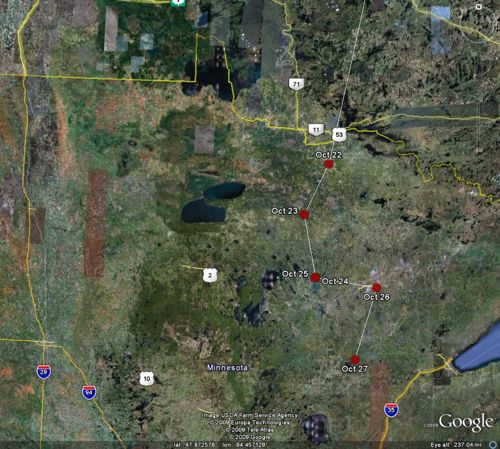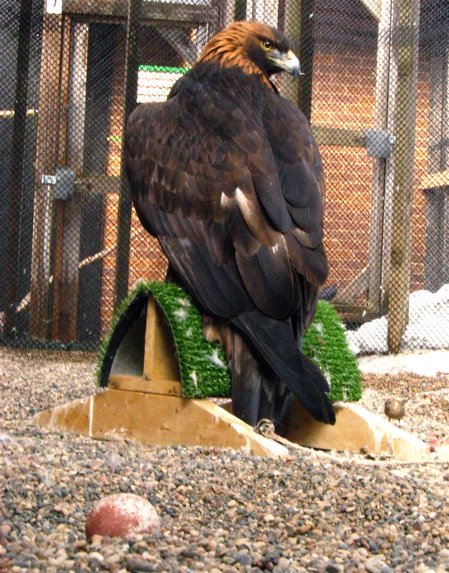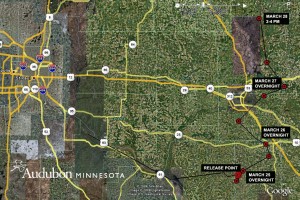If you're looking for links of what I talked about on KARE 11's Showcase Minnesota today, here they are:
Sign up for the Minnesota Breeding Bird Atlas (a monumental project run by Bonnie Sample whom I've known from banding birds at Carpenter Nature Center) that needs volunteers and reports of birds breeding all over the state of Minnesota. This is a huge project that no one birding organization has been able to organize before. It's spearheaded by Minnesota Audubon, but will involve several state and national organizations.
The other item I talked about was Woodworking for Wildlife, my buddy Carrol Henderson's book on building nesting houses and platforms for just about any bird that will use them.

Last week, I was privleged to join my buddy Mark Martell out on the St Croix River to band young bald eagles. Above is a 5 week old bald eagle wondering what the heck is going on. Hard to take them seriously as a top predator on the food chain when their beaks look like giant schnozzes.

We had a map with notes marking where eagle nests had been spotted in the spring. We took the boat out to have a look--some were easy to find like the above nest. It's huge because the eagles have been adding to it a little every year. The birds will do this year after year until the tree can no longer support the weight of the nest or wind knocks it down.

Speaking of wind, we were banding on Wednesday--the day it was super windy in Minnesota. Normally, the tree climber who goes up to get the chicks, uses a bow and arrow, shoots and arrow with a rope over a strong branch above the nest to rappel up, but the wind was just too strong and took the arrow anyplace but where the climber needed it.

He eventually decided to climb the tree the old fashioned way. It took longer, but was the only option. Above is a photo of Dan the climber next to the eagle nest...did I mention that Dan is six feet tall? Keep that in mind as he stands next to the nest--it has to be eight feet long at least.
Speaking of Dan Kraus our climber, he has an AWESOME website called Cat In A Tree Rescue. It's a directory of tree climbers all over the country who help cats stuck in trees. If your cat is stuck in a tree, you can find a climber near you to get it down. There's a gallery on the site of cats he's rescued, if you'd like to so see some indignant kitties, check it out. My personal favorite is poor Kit Kat.

When the birds are out of the nest, we determine the age--above is a 5 week old eaglet which is ideal. Their feet are as big as they are going to get, but their flight feathers are not developed, so the bird won't fly from the nest too soon when the climber goes up the tree. Mark Martell banded the bird, took a blood sample and a couple of down feathers for DNA samples. With the type of testing they are able to do now, the climber can even bring down adult eagle feathers from the nest and if they have been banded by Mark, they can tell which bird it is based on the DNA.

Mark told me that earlier in the week when they had been banding eaglets, they had an interesting banding return. As the group approached the nest, an adult eagle flew in carrying prey and dropped it off. As the climber when up the tree, the adult took off. When he got up, he saw the prey item--it was a blue-winged teal and it was banded! He took down the band numbers and gave it to the banders when he brought down the chicks. It's rare enough to get a banding return, but to get a banding return while you are banding a different species is as rare as it gets. I'll be curious to hear about the teal's history.

Dan the climber was gracious enough to take my camera up with him when we returned the chicks and get a photo from their nest. What a view of the St. Croix River! Note how the chick's foot is sticking way out--that's normal, eaglets at 5 weeks haven't quite figured out what formidable weapons and tools those toes can be. Check out this video of Mark putting an eaglet in a bag to be taken up to the nest (keeping them in a dark cloth bag keeps them from flailing and keeps them from injuring their growing feathers). But watch how the eaglet starts to flex those talons, it's a little awkward, but foreshadowing what they can do when they grow up:
[youtube]http://www.youtube.com/watch?v=3USA2Fk0eiw[/youtube]
While we were banding eagles, we had other species checking us out.

A common yellowthroat flitted around us--it got within 10 feet, giving chip notes. After about three minutes, it seemed to realize that we had no interest in it and only the giant birds, it started singing territory song in the open. I took a few photos before we boarded the boat to check the next test.

There was also a pair of tree swallows nesting in an old tree riddled with woodpecker holes. This one kept peering out like a nosy neighbor. "Abner, what are they up to out there? You should come see this! You won't believe it!"
There were also a TON of prothonotary warblers around us. The eagles' nests are in perfect prothonoray habitat--sloughs with over-turned trees. However, they are a bit more shy and we're moving too much. Being constantly on the move and working with eagles does not make for the best conditions to get a photo of a prothonotary warbler.

We went to check a couple of other nests and were not as successful. This nest was used last summer, but had shrank considerably.

You could see half the nest had ended up on the ground. Either a branch supporting the nest had broke or a late summer storm blew it down.

There was evidence that the remaining nest had been used--check out all of this poop. I suppected owl poop and had my suspicions confirmed when...

...we found pellets with bones and feather shafts. Owl pellets will have bone fragments because they tend to swallow prey whole or in large chunks. Also, there digestive acids are not as strong as a hawk or eagle. This one looked to have been eating a good-sized bird. I even found some rusty colored breast feathers. I wondered if the owl had eaten a duck and wondered what species.

Searching through more pellets revealed more bones...and the tip of a duck beak. The tip appeared to have a bump, so based on that, the breast feathers in the pellet, the size of bones, I suspect that the owl ate a wood duck. Great horned owls would have already left the nest by now. My guess is that part of this eagle nest fell last fall, a great horned nested in the remains in January, and the young were already hunting somewhere in the woods around us.

The third nest we checked was almost gone, so we did not get to band any birds there. However, we did get to do some work at the first nest and a slow day on the river is better than a good day at a desk. It was a treat to be out with the eagle banding crew to see the work that that they do.
 Golden Eagle 42 is still bookin' it south in Minnesota and taking an interesting way down towards Wabasha. Mark Martell reported this morning:
Golden Eagle 42 is still bookin' it south in Minnesota and taking an interesting way down towards Wabasha. Mark Martell reported this morning:
















